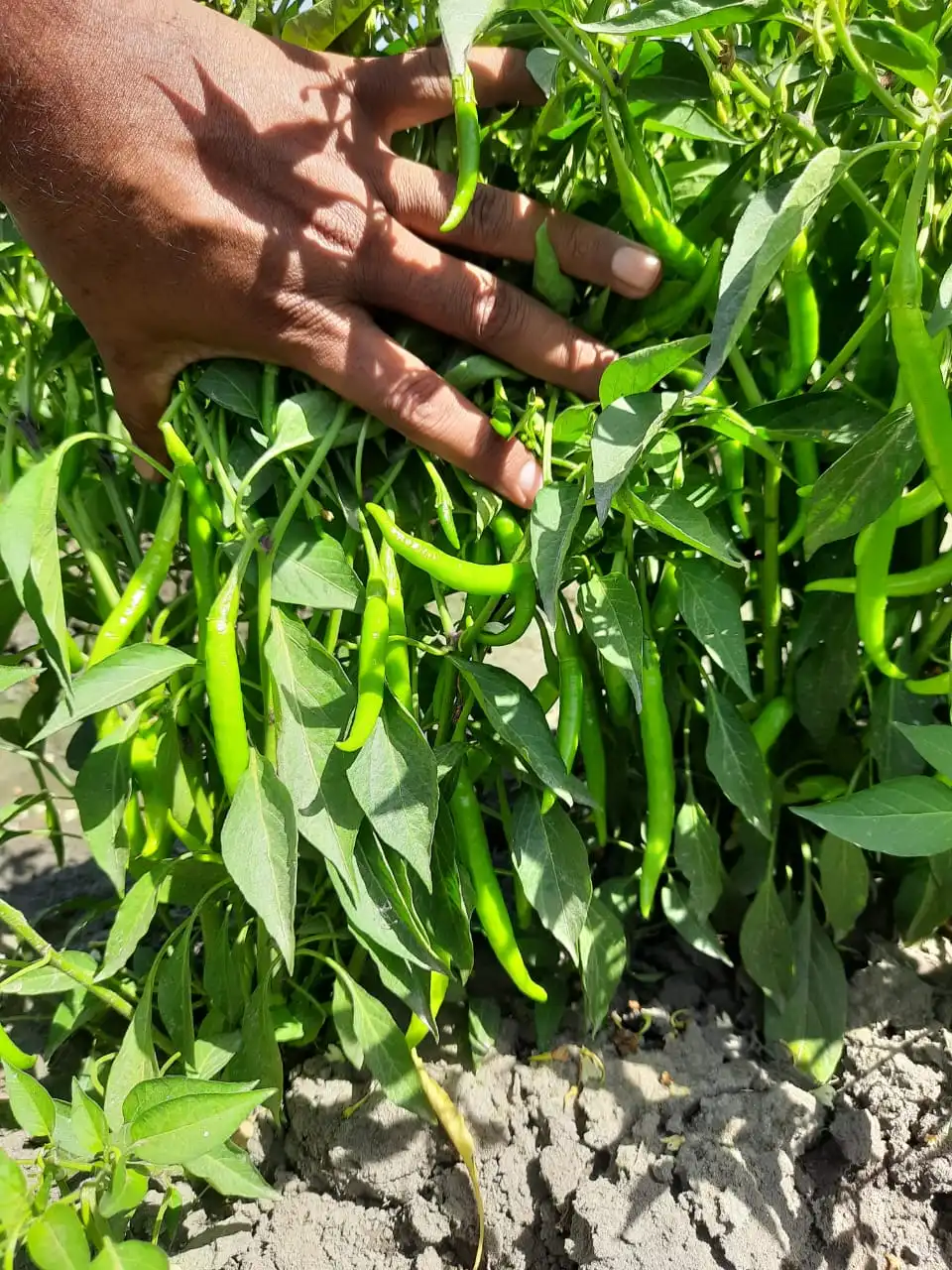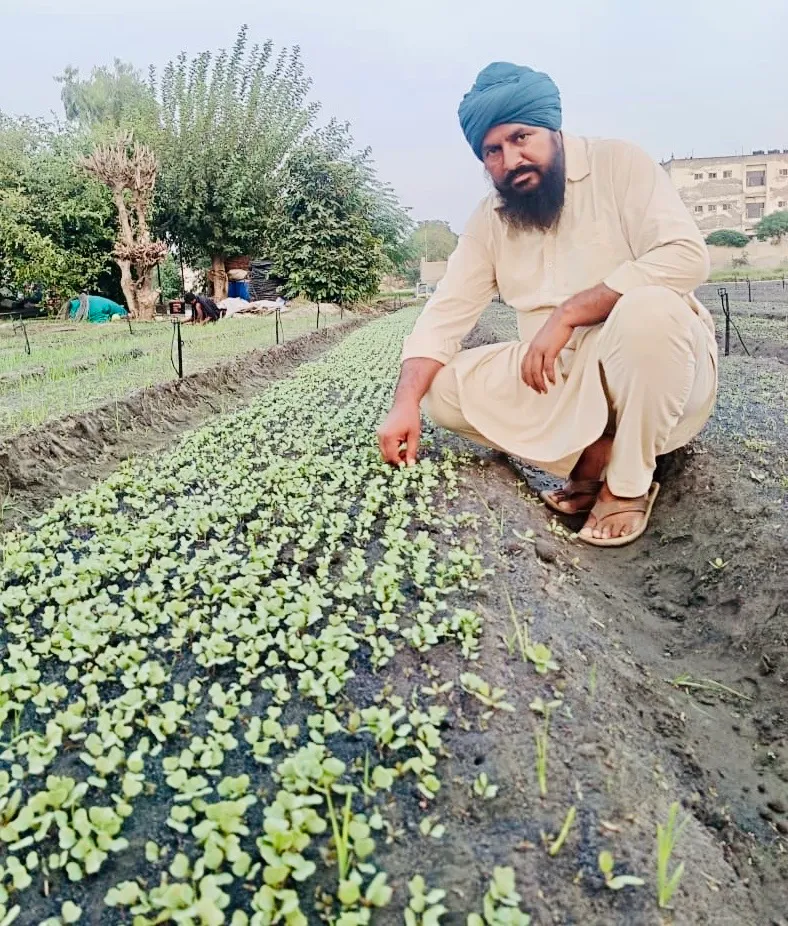Breaking free from wheat, marginal farmers in Ferozepur start chilli cultivation, uplift others
An acre of green chilli cultivation can produce around 250 quintals, while red chilli yields 80 to 120 quintals per acre.
 Shamsher has vegetable nurseries, including a chilli nursery, on 1-acre of his land, which supports the plantation of chillies across 275 acres.
Shamsher has vegetable nurseries, including a chilli nursery, on 1-acre of his land, which supports the plantation of chillies across 275 acres. In Hakumat Singh Wala village of Ferozepur, Shamsher Singh, 41, a marginal farmer with 2.5 acres, has turned his fate by shifting from traditional wheat farming to chilli cultivation.
Over the past decade, Shamsher not only improved his financial standing but is also a part of a group of 20 chilli growers including small and marginal who are purchasing the chilli crop from several farmers in Punjab at a Minimum Support Price (MSP), a price typically not offered by the government for crops other than wheat and paddy. He ensures that the small scale farmers are not left out in the volatile market.
Shamsher has vegetable nurseries, including a chilli nursery, on 1-acre of his land, which supports the plantation of chillies across 275 acres. To expand his operations, he leases 10 acres at Rs 64,000 per acre annually, where he focuses on chilli farming. He and his group buy chillies from small-scale farmers who struggle to find a market, ensuring they receive a fair price equivalent to MSP. Singh’s group purchases chillies from farmers at a guaranteed rate. The chilli farming process begins in early October, when the nursery is planted. After 40 to 45 days, the seedlings are transplanted into the main field. To protect the seedlings from winter, farmers cover them with polythene sheets supported by iron wire in 4-foot-high tunnels, which is called low tunnel farming. These tunnels help maintain optimal temperatures and the sheets are removed by mid-February. The first harvest takes place by March end, and farmers can take up to six pickings of green Chilli until July. For red chillies, farmers can take two pickings in April and June.
 The chilli farming process begins in early October, when the nursery is planted. After 40 to 45 days, the seedlings are transplanted into the main field.
The chilli farming process begins in early October, when the nursery is planted. After 40 to 45 days, the seedlings are transplanted into the main field.
He explains that growing chillies nursery requires an initial investment of 18 to 20 kg of seed per acre, costing between Rs 27,000 and Rs 45,000 per kg. Labour charges for growing chilli nursery in one acre is around Rs 1 lakh. Despite the high upfront costs, the returns are rewarding. A farmer can sell 40-45 days old chilli nurseries for Rs 18 to Rs 20 lakh and earn Rs 9 to Rs 10 lakh within the short period.
An acre of green chilli cultivation can produce around 250 quintals, while red chilli yields 80 to 120 quintals per acre. Last year, green chilli prices ranged between Rs 10 and Rs 11 per kg, which was on the lower side, while red chilli fetched Rs 28 to Rs 30 per kg. After deducting all expenses, he adds that farmers can earn about Rs 1.5 lakh per acre from chilli farming — far more than the Rs 50,000 per acre they make from wheat, even when growing on their own land. As Shamsher takes two crops in a year the land rent costs him Rs 32,000 per acre per crop and even after that he can save more than one lakh per acre from chilli crop.
Balwinder Singh Mahalam of Mahalam village in Ferozepur, a fellow farmer in the same group, grows chillies on 20 acres, including 7 acres of his own and grows chilli nursery on less than one acre land to supply to chilli cultivation on 200 acres. He says their group sets the MSP based on the prevailing rates in major chilli markets such as Andhra Pradesh and Madhya Pradesh, ensuring farmers in Punjab receive a fair deal. The group helps small-scale chilli farmers, who often struggle to find buyers, by purchasing their produce at MSP, providing stability and security. Balwinder said that they are in the process of forming an organisation as currently they are also providing seedlings to the farmers.
 Shamsher Singh and his group buy chillies from small-scale farmers who struggle to find a market, ensuring they receive a fair price equivalent to MSP.
Shamsher Singh and his group buy chillies from small-scale farmers who struggle to find a market, ensuring they receive a fair price equivalent to MSP.
He says that there are four selling options for chillies — selling green chillies early if market rates are favorable, waiting for the chillies to turn red if rates are low, dry chilli, the rate of which is Rs 130 to Rs 170 per kg or they can store it if market is not favorable and sell it when the rates improve. “These many options are not available in any other horticulture crop, Balwinder says.
This flexibility is one of the major advantages of chilli farming, making it an attractive option for farmers looking to diversify, he says, adding that in Ferozepur and surrounding areas several farmers are now growing chillies and the talks of its export are also going on as the samples of our chilli got passed. “Our chilli has no harmful chemicals as we use the recommended fertilises and pesticides in a very small amount,” he says, adding that director Horticulture department Shailender Kaur has been supporting the chilli farmers in all possible manner so that farmers can earn a fair price from it.
Simran Singh, officer of Ferozepur Horticulture Development, says that in Ferozepur around 10,000 acres are dedicated to chilli farming, with farmers cultivating the crop on plots ranging from 1 acre to even 100 acres. “The trend is shifting, with more farmers preferring to bring red chillies to the market as it saves on labour costs. Red chillies require only two pickings, whereas green chillies need more frequent harvesting, leading to higher labor expenses. Additionally, red chillies fetch a better price. Even in a bad season, farmers can earn up to Rs 1 lakh per acre after covering all expenses,” he says, adding that they are in talks with senior authorities to explore export opportunities for green chillies.












